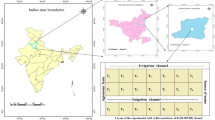Abstract
In wetland ecosystem, nitrogen along with other elements and its management is most imperative for the production of so many aquatic food, non-food and beneficial medicinal plants and for the improvement of soil and water characteristics. With great significant importance of INM (integrated nutrient management) as sources, emphasizing on management on nitrogen as a key element and its divergence, a case study was undertaken on such aquatic food crops (starch and protein-rich, most popular and remunerative) in the farmers’ field of low-lying ‘Tal’ situation of New Alluvial Zone of Indian subtropics. The study was designed in factorial randomized block design, where, three important aquatic food crops (water chestnut (Trapa bispinosa Roxb.), makhana (Euryale ferox Salisb.) and water lily (Nymphaea spp.) as major factor and eleven combinations of organic and inorganic sources of nutrients as sub-factor was considered in the experiment. It revealed from the results that the production of fresh kernels or nuts of water chestnut (8.57 t ha−1), matured nut yield of makhana (3.06t ha−1) and flower stalks of water-lily as vegetables (6.38 t ha−1) including its nutritional quality (starch, protein, sugar and minerals) was remarkably influenced with the application of both organic (neem oilcake @ 0.2 t ha−1) and inorganic sources (NPK @ 30:20:20 kg ha−1 along with spraying of NPK @ 0.5% each over crop canopy at 20 days interval after transplanting) than the other INM combinations applied to the crops. Among the crops, highest WCYE (water chestnut yield equivalence) exhibited in makhana due to its high price of popped-form in the country, which is being exported to other countries at now. Sole application of both (organic and inorganic sources) with lower range did not produce any significant outcome from the study and exhibited lower value for all the crops. Besides production of food crops, INM also greatly influenced the soil and water characterization and it was favourably reflected in this study. The physico-chemical characteristics of soil (textural class, pH, organic carbon, organic matter, ammoniacal nitrogen, nitrate nitrogen, available nitrogen, phosphorus and potassium) are most important and contributed a significant improvement due to cultivation of these aquatic crops. Analysis of such wet bodies represented the water characteristics (pH, BOD, COD, CO =3 , HCO −3 , NO −3 N, SO −4 S and Cl−) were most responsive, adaptable and quite favourable for the cultivation of these crops in this vast waste unused wetlands for the mankind without any environmental degradation.
Similar content being viewed by others
Abbreviations
- AAS:
-
Atomic absorption spectrophotometer
- BOD:
-
Biological oxygen demand
- COD:
-
Chemical oxygen demand
- DAT:
-
Days after transplanting
- eq:
-
Equivalent to
- GMR:
-
Gross monetary return
- Mak:
-
makhana
- MSL:
-
Mean sea level
- NP:
-
Net profit
- Rs:
-
Indian Rupees
- WC:
-
Water chestnut
- WCYE:
-
Water chestnut yield equivalence
- WL:
-
Water lily
References
Tiner, R. W., Wetlands are ecotones: Reality or myth? in Wetlands and Ecotones-Studies on Land-water Interaction (eds. Gopal, B. et al.), National Institute of Ecology, New Delhi, 1993, 1–15.
Puste, A. M., in Agronomic Management of Wetland Crops, Ludhiana: Kalyani Publishers, India, 2004, 1–56.
Shukla, V. C., Mishra, U. N., Indian Farming Dig., 1970, 3: 45.
Chakor, I. S., Indian Farming Dig., 1974, 7: 35.
Puste, A. M., Das, D. K., Optimization of aquatic-terrestrial ecosystem in relation to soil nitrogen status for the cultivation offish and aquatic food crops of the Indian subtropics, TheScientific-World, 2001, 1(S2): 130–134.
Author information
Authors and Affiliations
Corresponding author
Rights and permissions
About this article
Cite this article
Puste, A.M., Sarkar, P.K. & Das, D.K. Balanced nitrogen economy as a flexible strategy on yield stabilizing and quality of aquatic food crops in wetland ecosystem. Sci. China Ser. C.-Life Sci. 48 (Suppl 2), 980–987 (2005). https://doi.org/10.1007/BF03187136
Received:
Issue Date:
DOI: https://doi.org/10.1007/BF03187136



